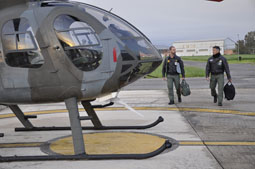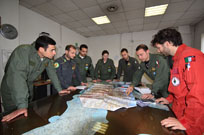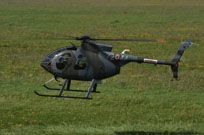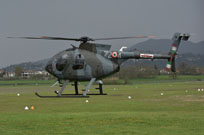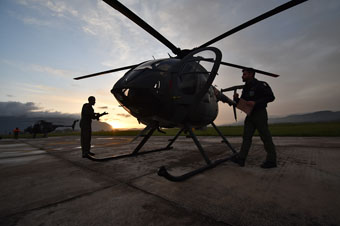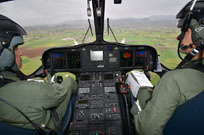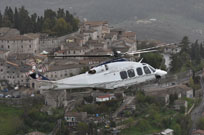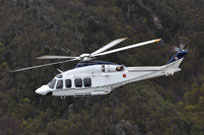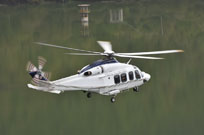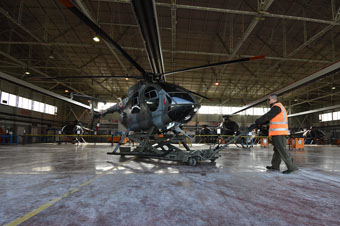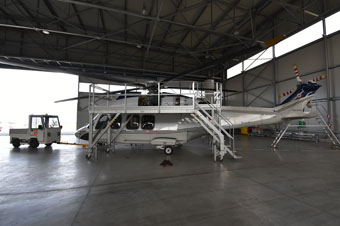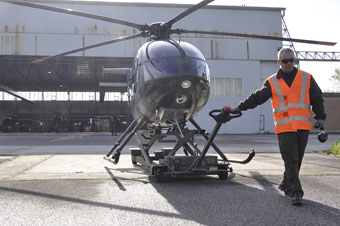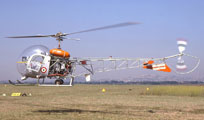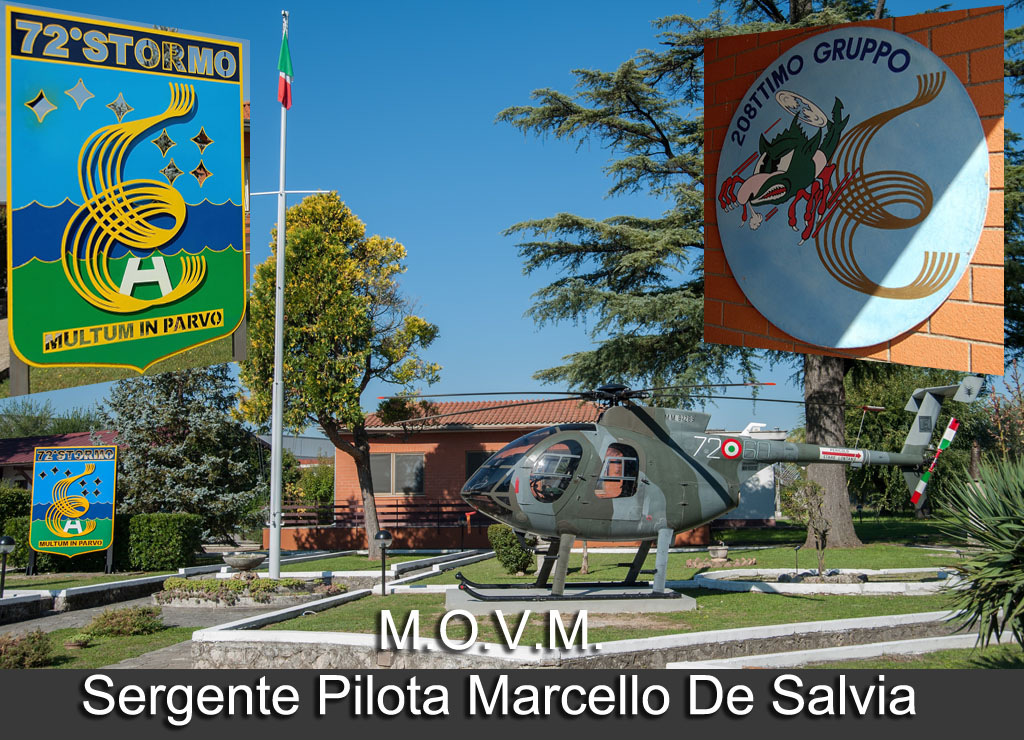 |
|
Organizzazione
Il 72° Stormo è stato costituito il 1° novembre del 1985 sull’aeroporto di Frosinone, dipende dal Comando Scuole/3ª Regione Aerea con sede a Bari ed è incaricato della formazione dei piloti di elicottero dell'Aeronautica Militare, delle altre Forze Armate e dei Corpi Armati dello Stato, nonché dei frequentatori di aeronautiche estere.
La sua struttura è di tipo standard come qualsiasi altro reparto analogo, dal 72° Stormo dipendono il 208° Gruppo Volo, il GEA (Gruppo Efficienza Aeromobili), il GIP (Gruppo Istruzione Professionale), il 472° Gruppo STO (Servizio Tecnico Operativo), il 572° Gruppo SLO (Servizio Logistico Operativo), la CPF (Compagnia Protezione delle Forze), il Servizio Amministrativo e l’Infermeria di Corpo.
La missione principale dello Stormo è quella di addestrare i futuri piloti dell’Aeronautica Militare, destinati alla linea ala rotante presso, i Reparti della Forza Aerea dotati di elicotteri sono il 15° Stormo di Cervia, con relativi Centri SAR di: Trapani, Gioia del Colle, Pratica di Mare e Decimomannu, ed il 9° Stormo di Grazzanise.
Le linee volo sono dotate di: HH 139A, (presso lo stesso 72° Stormo è presente anche la versione UH139 – Utility Helicopter, e presso il 31° Stormo la versione VH139 – VIP Helicopter) HH 101A, HH 212 e TH 500B.
Inoltre, lo Stormo, in caso di necessità, concorre allo svolgimento di altri compiti istituzionali, come: operazioni SAR (Search and Rescue), Protezione Civile, OFCN (Operazioni Fuori dai Confini Nazionali) in missioni di pace, supporto alla difesa delle basi aeree ed installazioni militari in generale durante i periodi di crisi o guerra.
In particolare riportiamo le missioni di pace più significative a cui hanno partecipato gli equipaggi del 72°:
-Albania Luglio 1999 - Giugno 2000
-Eritrea Novembre 2000 - Luglio 2001
-Kosovo Giugno 2000 - Dicembre 2003
Il 20 marzo del 2005, il 72° Stormo è stato intitolato al Sergente Pilota MOVM Marcello De Salvia, “Prima ed Unica Medaglia d’Oro al Valor Militare che ha messo le ali a Frosinone”, questa la motivazione per cui gli è stato intitolato lo Stormo.
|
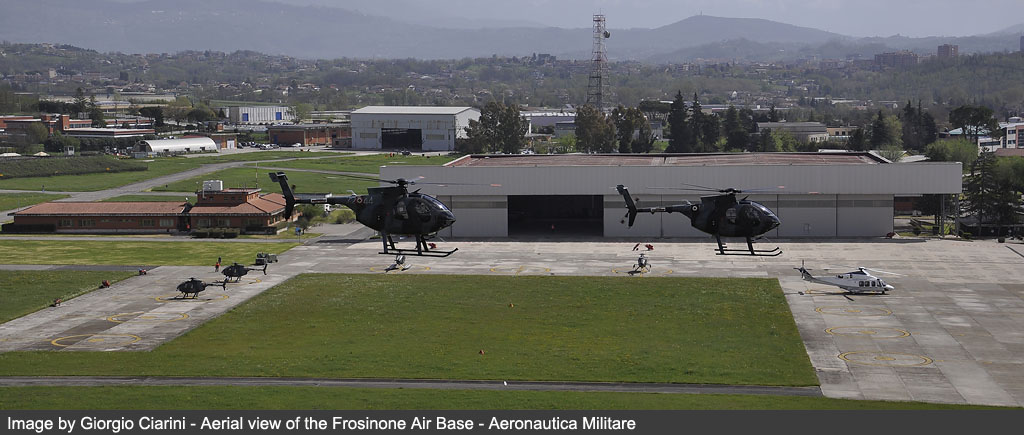 |
|
Aeroporto
L’aeroporto di Frosinone, cittadina posta nel Lazio meridionale o più comunemente chiamata “Ciociaria”, inizia a svilupparsi nel lontano dicembre del 1936 con disposizione del Ministero dell’Aeronautica, contestualmente assume l’intitolazione dedicata al Capitano Girolamo Moscardini, valoroso Pilota deceduto a Ronco di Castellanza di Varese il 3 agosto 1932 per incidente di volo.
Questo avviene dopo che per anni l’aeroporto era considerato solo un campo di fortuna, la svolta avviene appunto nel 1936 dopo un’ispezione fatta per valutare se il campo era adeguato ad essere utilizzato per un intensa attività di volo e se c’erano delle difficoltà logistiche nel portare in loco materiali ed attrezzature, la valutazione finale dell’ispezione era stata favorevole.
Nel periodo 1936-39 vengono eseguiti diversi lavori e in data 5 marzo 1939 viene disposto che il “Campo di Fortuna di Frosinone” assume la classificazione di Aeroporto Armato di 3ª Classe. Nel novembre del 1939 inizia il primo corso di Primo Periodo per Sottufficiali piloti, proprio in questo corso fa la sua comparsa il giovane Marcello De Salvia che dimostra subito le sue capacità di pilotaggio con un Breda.28, capacità consolidate proseguendo con l’addestramento di Secondo Periodo su velivoli da caccia.
Nel dopoguerra la Scuola Addestramento, Bombardamento e Caccia definita scherzosamente “scuola A-B-C” si trasferisce da Gaudo (Sa) a Frosinone portando con sé in dote alcuni Aircobra P 39, Spitfire V.b e Martin A 30 Baltimore e successivamente alcuni S.79, ancora più avanti si aggiungono alla linea di volo, a quel punto molto eterogenea, un Cant/Z1007/ter ed un SM.84. La scuola perde le caratteristiche di scuola caccia e bombardamento con l’accantonamento dei P 39 e Spitfire, arrivano però i Saiman 202, e iniziano anche dei corsi per “navigatori”.
Successivamente affluiscono sul campo di Frosinone per tempi più o meno lunghi dei: C 47 Dakota, Fiat G 12, G 46 e G 59; L 5, Macchi 416, Piaggio P 148, Mustang P 51 e bimotori Beechcraft C 45.
Un passaggio importante avviene nel 1954-55, quando l’intera riorganizzazione di quel periodo porta alla costituzione della Scuola Plurimotori che però invece di rimanere a Frosinone viene trasferita sul vicino aeroporto di Latina, così facendo i velivoli ad ala fissa lasciano il posto all’ala rotante, infatti per colmare il vuoto viene portato a Frosinone il Centro Elicotteri (CE), denominazione assunta in quell’occasione dal Reparto Addestramento Elicotteri (RAE).
|
 |
 |
|
|
 |
|
|
|
Ground School
La Ground School è la parte addestrativa propedeutica che precede l’attività di volo a bordo degli elicotteri, di questa importante fase se ne occupa il GIP (Gruppo Istruzione Professionale), che segue e organizza le lezioni in aula e le sessioni a bordo del simulatore.
L’attività multimediale ha radici molto profonde a Frosinone, già dal 1997, con la creazione del sistema didattico multimediale INSIAU (Insegnamento Interattivo Allievi Ufficiali), sistema sviluppato da una ditta specializzata con il contributo del personale dello Stormo, gli istruttori del 72° Stormo utilizzano sistemi computerizzati per svolgere le lezioni teoriche in aula.
Tramite i 25 PC “postazione allievo”, sui quali è installato un software didattico appositamente realizzato, e connessi via LAN attraverso l’infrastruttura appositamente denominata “AULA INSIAU”, i frequentatori svolgono un ciclo di addestramento intensivo per una durata di 3/7 settimane, ciclo regolato in base alla tipologia di corso.
Nel corso sono studiate 14 materie diverse, per un totale di oltre 200 lezioni ad elevato contenuto multimediale (filmati, animazioni, audio, immagini ecc.) che costituiscono il background culturale indispensabile alla prosecuzione dell’iter addestrativo.
Il docente, tramite il PC “postazione insegnante”, supervisiona lo svolgimento delle lezioni, controllando il raggiungimento degli obiettivi formativi attraverso diverse tipologie di test di verifica e, laddove ritenuto opportuno, interviene personalmente per approfondimenti e chiarimenti, il tutto impiegando i diversi dispositivi hardware e software messi a disposizione dal sistema.
Tra il 2007 e il 2008, il sistema didattico multimediale INSIAU, è stato oggetto di un profondo rinnovamento tecnologico sia dal punto di vista software che dal punto di vista hardware.
Il naturale aggiornamento delle componenti hardware e soprattutto dei sistemi operativi, ha reso incompatibili i vecchi software utilizzati inizialmente per sviluppare le lezioni, si è così reso necessario aggiornare i software. La disponibilità dei files sorgenti delle lezioni è stato un elemento fondamentale per rendere possibile la trasformazione del sistema, questa volta impiegando esclusivamente personale militare dello Stormo. Dopo un intenso lavoro di conversione dei contenuti multimediali e migrazione su di una versione Web compliant è stato testato il sistema su di un server interno.
A questo punto, verificata l’efficacia del sistema, si è deciso di puntare più in alto, rendendo così possibile la fruizione a distanza dei contenuti didattici via Web. Allo scopo si è deciso di utilizzare la piattaforma didattica open-source e-learning Moodle, universalmente riconosciuto come sistema di punta per l’insegnamento in modalità e-learning. I contenuti didattici sono stati quindi installati su un Web server esterno e distribuiti ai frequentatori via Internet e impiegati per lo svolgimento di corsi “ALA ROTANTE” per personale addetto alla manutenzione aeromobili.
Questa esperienza è stata la “prima volta” in assoluto per un ente dell’Aeronautica Militare tanto che è stata citata come esempio di riferimento durante il Moodlemoot Italia del 2008, meeting annuale di tutte le istituzioni utilizzatrici della piattaforma, tenutasi presso l’Università Roma 3.
Grazie a questo successo l’Aeronautica Militare ha quindi deciso di inglobare nel proprio ambiente multimediale, denominato “AM e-learning”, la sezione dedicata al Comando Scuole “CSAM e-learning”, garantendo così ai frequentatori la possibilità di usufruire delle lezioni sia via Internet che via Aeronet.
Successivamente il sistema è stato oggetto di ulteriore revisione con la produzione di contenuti in lingua inglese a beneficio dei frequentatori stranieri.
Grazie a questo, è nato il cosiddetto progetto INSIAU e-learning che si prefigge l’obiettivo di permettere al frequentatore di svolgere la maggior parte della fase teorica via Internet assicurando comunque un elevato standard qualitativo, rimanendo presso il proprio ente di appartenenza, con un conseguente congruo risparmio economico.
Inoltre, ancora nell’ambito del suddetto rinnovamento tecnologico, ai frequentatori è stata data la possibilità di accedere alle loro lezioni anche dopo il normale orario di servizio per garantire continuità e disponibilità didattica. Questo si è reso possibile grazie all’installazione presso i loro alloggi di una rete V-Lan wireless tramite la quale, utilizzando un Notebook fornito dallo Stormo, possono collegarsi al Web server dell’aula 24 ore su 24.
|
 |
 |
|
|
|
Simulatore
Il 72° Stormo è dotato di un simulatore di volo del TH-500B, vettore principale dello Stormo. L’apparato è stato inaugurato il 13 settembre 2013, alla presenza dell’allora Capo di SMA Generale di Squadra Aerea Pasquale Preziosa e dall’Amministratore Delegato di Selex ES l’Ing. Fabrizio Giulianini. Impostato su di un velivolo dismesso, ha incrementato la qualità degli standard addestrativi degli equipaggi su ala rotante. A bordo, possono essere riprodotte tutte le normali operazioni di volo reali, le diverse condizioni meteo con particolare attenzione alle attività di volo IMCS (Instrument Meteorological Conditions Simulated - volo in condizioni di bassa visibilità) che ha consentito di implementare in maniera esponenziale l’addestramento al volo strumentale.
Altro aspetto fondamentale è la capacità di simulare tutte le emergenze di volo contemplate per il TH-500B. L’utilizzo dei simulatori di volo, permette di addestrare in sicurezza il frequentatore su manovre di volo che consentono la risoluzione di problematiche e avarie che prima non era possibile simulare nella realtà.
Questo patrimonio consente altresì lo svolgimento dei corsi MCCH (Multi Crew Cooperation Helicopters) ed MCCI (Multi Crew Cooperation Instructional), indispensabili per sviluppare la capacità degli equipaggi di operare in maniera sinergica a bordo dei vari elicotteri in dotazione alle FF.AA. e Corpi dello Stato.
Il 72° Stormo sarà dotato di un ulteriore simulatore. Trattasi di un dispositivo FNPT (Flight and Navigation Procedure Trainer) che permetterà di integrare l'attività di volo su elicottero bimotore con quella sintetica. L'addestramento al volo strumentale sarà aggiornato con corsi sulla PBN (Performance Based Navigation) e gli equipaggi potranno implementare le proprie capacità grazie alla simulazione di emergenze nelle varie condizioni di volo ed ai nuovi corsi di MCC (Multi Crew Cooperation). Consentirà inoltre di rilasciare determinate qualifiche secondo gli standard addestrativi previsti da EASA.
Non ultimo il rapporto inversamente proporzionale tra l’accrescimento della capacità addestrativa a fronte dell’abbattimento dei costi dell’attività di volo.
|
|
|
|
NH 500E
L’NH 500E (Designazione Armaereo TH 500B) è un derivato dell’originale OH 6 Cayuse, modello di successo della Hughes e costruito attualmente dalla MD Helicopters come MD 500. In Italia gli NH 500 sono stati costruiti su licenza dalla Breda-Nardi di Monteprandone (AP), società acquisita a sua volta da Agusta nel 1989.
L’NH 500E è un elicottero leggero multiruolo dall'elevata flessibilità d'impiego, e grazie alle sue caratteristiche ne hanno fatto un velivolo di largo impiego in ogni angolo del pianeta sia per scopi militari che civili. Il primo di 50 elicotteri è stato consegnato all’Aeronautica Militare il 26 Maggio 1990, elicottero molto robusto e affidabile può essere utilizzato in varie configurazioni, con galleggianti, con barelle, con pattini da neve, con verricello e gancio baricentrico e infine con armamento di tipo lanciarazzi o mitragliatrici.
Con l’NH-500E, pur non essendo una macchina IFR (Instrumental Flight Rules), rende possibile svolgere un addestramento al volo strumentale, con le regole del volo a vista.
|
|
Caratteristiche Tecniche
Rotore pentapala articolato
Diametro disco rotore 8,04 m
Superficie rotore 50,89 mq
Altezza 2,83 m
Lunghezza 9,40 m
Larghezza 8,04 m
Peso massimo al decollo 1.310 kg
Velocità massima 281 km/h
Tangenza 5.000 m
Autonomia 420 km
Equipaggio due piloti e due passeggeri
Propulsione Allison 250-C.20.B
Potenza 420 hp
|
Installazioni ausiliarie
Verricello da 136 kg max
Gancio baricentrico da 907 kg max
Tranciacavi
Secchio antincendio da 530 lt.
Galleggianti fissi
Pattini da neve
Razziere da 14 razzi cal. 50 mm
Serbatoio ausiliare da 186 lt
Mitragliatrice cal. 5,56 mm
Barella singola o doppia
|
Avionica
Comunicazioni in VHF-UHF
Interfonico
Identificazioni IFF-CPI
Navigazione VOR, ADF, DME
ILS con intercettazione automatica del sentiero
Autopilota
Radaltimetro
ELT (Emergency Locator Transmitter)
|
|
 |
|
|
|
Syllabus Addestrativo
Il 72° Stormo è una scuola di volo dell’Aeronautica Militare che si caratterizza per la sua innata connotazione interforze ed interagenzia, in cui confluiscono, oltre agli allievi dell’Aeronautica Militare, anche quelli di altre Forze Armate (Esercito, Carabinieri) e Corpi Armati dello Stato (Guardia di Finanza, Polizia di Stato e Capitaneria di Porto). A questi si aggiungono anche gli aspiranti selezionati dal Corpo dei Vigili del Fuoco.
L’iter formativo presso la scuola di Frosinone è paritetico per tutti i frequentatori, senza distinzioni rispetto al Corpo di provenienza. Quello che cambia è il background formativo con cui gli allievi dell’AM giungono al reparto e che li differenzia dal resto dei colleghi.
I cadetti, infatti, dopo il periodo iniziale in Accademia Aeronautica sono inviati alla scuola di volo di Latina, sede del 70° Stormo, affrontano una prima fase di addestramento al volo (Fase I) al cui termine ricevono il BPA (Brevetto di Pilota d’Aeroplano). A seguire affrontano la Fase II, anche detta "Primary Pilot Training" - comune a tutti gli allievi piloti militari, finalizzata all'individuazione della linea su cui essi saranno impiegati in base alle loro attitudini e potenzialità (fast jet, pilotaggio remoto RPA, elicotteri, trasporti). Se idonei, possono accedere ai corsi previsti presso il 72° Stormo che li porterà ad ottenere il BPM-HT (Brevetto di Pilota Militare – Helicopter Track).
Il nuovo syllabus, adottato dal 2016, prevede quindi un percorso nettamente diverso rispetto a prima (dove tutti i piloti venivano abilitati sulle linee jet e, solo dopo, inviati presso le scuole specializzate) permettendo un maggior numero di ore di volo sui velivoli cui saranno assegnati con conseguente abbattimento dei costi, oltre che ad un addestramento più mirato.
Gli allievi provenienti dall’Esercito, dalla Guardia di Finanza e dai Carabinieri, invece, sono pre-selezionati dai propri enti e arrivano presso la scuola senza pregresse esperienze di volo. Al termine dell’abilitazione ricevono il BPME (Brevetto di Pilota Militare d’Elicottero).
Per quanto riguarda la Polizia di Stato e i Vigili del Fuoco, il percorso è del tutto simile a quello degli allievi dell’Esercito, piuttosto che della Guardia di Finanza o dal Corpo dei Carabinieri, ma essendo personale civile ricevono il BPE (Brevetto di Pilota d’Elicottero).
Gli allievi della Capitaneria di Porto, al contrario, affrontano un percorso leggermente diverso: essi conseguono il BPM presso la scuola di volo della United States Navy di Corpus Christi, in Texas, dove ricevono le cosiddette “Golden Wings” come piloti di ala fissa. Gli stessi frequentatori affrontano poi a Frosinone un corso denominato di Abilitazione su Elicottero.
Da qui in poi tutti i frequentatori devono sostenere lo stesso percorso che ha inizio con una fase di istruzione a terra erogata con metodi innovativi, e all’avanguardia, utilizzando strumenti di e-learning. Fondamentale in questa fase è l’apporto fornito dal GIP – Gruppo Istruzione Professionale, istituito nel 1986 (inizialmente denominato GIT – Gruppo Istruzione a Terra) e che già dal 1999 ha iniziato a fornire lezioni tramite un’apposita piattaforma online aperta e fruibile da ogni frequentatore sia presso il proprio reparto di appartenenza, ancora prima di giungere a Frosinone, sia presso le proprie abitazioni.
Da sottolineare, inoltre, che il GIP è certificato secondo gli standard UNI EN ISO 9001 per la progettazione dei propri corsi di volo in modalità residenziale ed e-learning, riconoscimento che attesta le grandi capacità del gruppo.
|
 |
|
|
Al termine dell’istruzione informatica, gli allievi sostengono un primo esame di sbarramento che, se superato, li fa accedere al programma successivo di preparazione in aula in presenza degli istruttori, alla Ground School per l’abilitazione al TH-500B e UH-139 e al primo approccio con la macchina che avviene, in forma virtuale, grazie all’ausilio di un simulatore di volo ideato e prodotto in collaborazione con l’azienda Selex ES. Il simulatore è di tipo fisso e può ricreare, tramite un generatore di immagini VIR3X, qualsiasi situazione di emergenza, di inviluppo, di condizioni meteo o di volo (strumentale e non).
Dopo il primo periodo teorico hanno inizio le fasi pratiche denominate IIIA e IIIB. Nella prima gli allievi volano circa 100 ore sui TH-500B dove apprendono le manovre basiche, i decolli e gli avvicinamenti, il volo in formazione e in formazione tattica, la navigazione a bassa quota e VFR (Visual Flight Rules), volo con gancio baricentrico e su specchi d’acqua e recupero con verricello. In questo step vengono studiate anche tutte le procedure di emergenza e, in particolare, quella dell’autorotazione.
Verso la fine del percorso didattico, i frequentatori approcciano ai primi rudimenti del volo strumentale con atterraggi assistiti dal sistema ILS (Instrumental Landing System) e GCA (Ground Controlled Approach) su aeroporti attrezzati, come quello di Grazzanise, oltre ad intercettazioni VOR-DME (Very High Frequency Omnidirectional Range - Distance Measuring Equipment) e NDB (Non-Directional Beacon). |
|
|
Al termine della Fase IIIA gli aspiranti devono sostenere l’esame di sbarramento che, se superato, gli permette di arrivare alla Fase IIIB che si svolge sull’UH-139 (multi-engine), con circa 50 ore di volo. In questo ambito i frequentatori affinano ulteriormente le capacità di volo strumentale e vengono istruiti alla MCC (Multi Crew Coordination) e al CRM (Crew Resource Management). Il corso composto da queste due fasi, che complessivamente dura circa 14 mesi, è molto completo e certifica i neo brevettati come EASA Compliant, ovvero la capacità di volare in qualsiasi spazio aereo e di operare, in totale sicurezza, entro il perimetro di qualsiasi ente controllore del traffico, sia esso civile o militare.
Presso il 72° Stormo sono tenuti anche i corsi PIT (Pilot Instructor Training) per istruttori di volo della durata di 15 settimane e 65 ore di volo. Di recente sono state attivate le procedure per abilitare i tutor all’insegnamento della PBN (Performance Based Navigation) che rappresenta il futuro della navigazione aerea assistita e che soppianterà in toto il principio dell'attuale navigazione convenzionale, in cui gli aeromobili sono guidati da segnali ricevuti da radioassistenze di terra (VOR, DME, ILS, ecc.). A sottolineare quanto la scuola di Frosinone sia all’avanguardia nel campo, già da qualche mese può disporre dei primi due istruttori con attestato PBN. Per ampliare ulteriormente le capacità in tal senso, a breve il simulatore del TH-500B sarà affiancato ed integrato da un altro dedicato all’UH-139 con capacità FNPT (Flight Navigation and Procedures Trainer), EASA Level III. Dalla costituzione della Scuola Frusinate sono stati brevettati circa 5.000 piloti e volate 467.719 ore.
Dal febbraio del 2018 la Guardia Costiera ha approfondito il rapporto già esistente con l’AM per il conseguimento del BMPE, stipulando un accordo con cui è stato anche deciso di mettere a disposizione del 72° Stormo un suo AW 139CP per un totale di 300 ore di volo annue. In tal modo, il corso di abilitazione all’elicottero dei suoi allievi (tutti provenienti dalle scuole di volo della US Navy) è stato rivisto, suddividendolo in 65 ore su TH-500B e 25 su AW 139.
|
 |
|
|
|
GEA
Il GEA (Gruppo Efficienza Aeromobili) dipende dal Comandante di Stormo, gestisce la flotta di elicotteri assegnati allo Stormo e si occupa della loro manutenzione nonché della gestione tecnica in linea volo.
La manutenzione dell’NH 500E è articolata su ispezioni prefissate alla scadenza delle 25 ore di volo e multipli, fino alle 100 ore, definite Ispezioni Intermedie e classificate come ispezioni di 1° Livello Tecnico.
L’ispezione maggiore di 2° Livello Tecnico della durata di circa cinque mesi avviene con lo scadere della terza ispezione delle 100 ore, oppure per il LIC (Limite di Impiego Calendariale) di 18 mesi di attività di volo. L’ispezione di 2° Livello Tecnico può essere svolta oltre che dal GEA anche dal 3° RMAA (Reparto Manutenzione Aeromobili e Armamento) di Treviso o dalla ditta MAG (Mecaer Aviation Group) di Monteprandone (AP).
Le attività del GEA sono rivolte anche al supporto didattico con proprio personale formatore dei corsi teorici dei frequentatori BPME.
|
 |
|
|
|
208° Gruppo
Il 208° Gruppo Volo, da leggersi 208ottimo, come da tradizione del reparto è stato costituito il 27 aprile del 1955 nell’ambito del Centro Elicotteri. Sin da allora il Gruppo è sempre stato “accompagnato” dalle Squadriglie 429ª e 430ª. La sua attività è sempre stata legata alle Scuole di Volo dedicate all’ala rotante, prima alle dipendenze del Centro Elicotteri, poi con la Scuola Elicotteri Aeronautica Militare ed infine con il 72° Stormo.
Dalla sua costituzione il reparto è sempre stato affiliato in modo imprescindibile all’aeroporto Frusinate.
|
 |
 |
|
|
|
Storia
La storia dello Stormo ha inizio l’11 febbraio del 1953 quando con un decreto dello Stato Maggiore dell’Aeronautica (SMA) viene costituito il RAE (Reparto Addestramento Elicotteri), basato sull’aeroporto di Roma Urbe. La dotazione iniziale è costituita da Westland WS-51 inglesi affiancati dai Bell B-47 D-1 americani, sostituiti già un anno dopo dagli AB-47G costruiti su licenza, in Italia dall’Agusta. Il 14 febbraio 1955 il RAE lascia la sua sede romana per trasferirsi sull’aeroporto G. Moscardini di Frosinone, assumendo la denominazione di Centro Elicotteri Aeronautica Militare. La sua struttura è articolata su un Gruppo Volo, il 208°, suddiviso a sua volta in due Squadriglie: la 429ª con compiti addestrativi, e la 430ª per l’impiego operativo.
Il 28 marzo 1957 viene consegnata la bandiera d’istituto mentre il 1° gennaio dell’anno successivo il 208°, divenuto nel frattempo Gruppo Volo Scuola, è affiancato dal 209° Gruppo che di fatto assorbe gli incarichi della 430ª Squadriglia. Nello stesso anno il 209° lascia Frosinone per basarsi a Roma Centocelle sui nuovi AB-47J; di fatto tutte le operazioni passano in mano al 208°, la cui linea è composta da un misto di vecchi AB-47G e alcuni “Jota”, costituendo il nucleo intorno al quale, il 15 febbraio del 1960, si forma la SVE (Scuola Volo Elicotteri). Già da questa data, la scuola è l’unica articolazione deputata all’addestramento dei piloti e specialisti dell’AM e dei Corpi Armati dello Stato destinati all’ala rotante.
La struttura del Reparto viene ingrandita e al 208° Gruppo è affiancato il Gruppo ERT, per la manutenzione dei velivoli, e il Gruppo SOG per il supporto logistico. Per i corsi di pre-selezione e pilotaggio basico vengono impiegati gli AB-47G, mentre gli allievi apprendono i primi rudimenti del volo strumentale sullo “Jota”. Alla scuola arrivano anche alcuni AB-204B utilizzati, per lo più, per addestramento pre-operativo e per soccorso.
Negli anni ’70 la flotta è ulteriormente integrata da alcuni Bell OH-13H (del tutto simili agli AB-47) di costruzione americana; il personale li soprannomina subito “i coreani” perché qualche elicottero aveva preso parte al conflitto di Corea negli anni ’50.
Il 1° novembre 1985, come detto, la scuola muta ancora la sua denominazione assumendo quella attuale di 72° Stormo, pur mantenendo inalterata la propria fisionomia operativa. Alle sue dirette dipendenze transita il 208° Gruppo che negli anni precedenti aveva brevettato oltre 2.500 piloti effettuando più di 225.000 ore di volo.
Nel frattempo (1985) iniziano le radiazioni del materiale di volo ritirando dapprima i vecchi AB-47J, per poi passare agli AB-204B, mentre già si pensava alla loro sostituzione nell’ottica di fornire agli allievi e istruttori una macchina più moderna e rispondente alle nuove esigenze della Forza Armata. Essa viene individuata, infine, nel Breda-Nardi Hughes 500E, già ampiamente diffuso nell’ambito degli operatori civili e militari, che entra ufficialmente in linea il 26 maggio del 1990. In attesa del nuovo elicottero sono stati affiancati agli ultimi AB 47G-2 due NH 500D, “anticipati” dalla Breda Nardi per permettere agli istruttori di effettuare il “passaggio macchina” ai nuovi elicotteri NH 500E che stanno per arrivare.
Per chiudere la parte storica ripercorriamo in maniera schematica le varie tappe della Scuola di Volo:
Dal 1939 al 1943 Scuola Pilotaggio Allievi Sottoufficiali
Dal 1945 al 1946 Scuola Addestramento Caccia e Bombardamento
Dal 1946 al 1947 Scuola Addestramento Trasporti
Dal 1948 al 1953 Scuola Addestramento Trasporti e Navigazione
Dal 1954 al 1955 Scuola Istruzione Equipaggi
Dal 1955 al 1960 Centro Elicotteri
Dal 1960 al 1985 Scuola Volo Elicotteri
Dal 1985 (1° novembre) ad oggi 72° Stormo
In questo dettaglio riepiloghiamo, invece, quali sono gli aeromobili utilizzati dalla Scuola:
-Dal 1953 al 1993 AB 47G-2
-Dal 1955 al 1983 AB 47J
-Dal 1962 al 1988 AB 204B
-Dal 1985 al 1990 NH 500D
-Dal 1990 ad oggi NH 500E
-Dal 2014 anche AW 139CP (Capitaneria di Porto – Guardia Costiera)
-Dal 2019 AB 206 (Vigili del Fuoco)
-Dal 2019 RH 206 (Aviazione dell’Esercito)
|
 |
 |
|
|
L’autore desidera ringraziare il: Gen. Baldi, Gen. Nuzzo, Gen. Colagrande, Gen. Tarantino, Col. Alberino, Col. Cipelletti, T.Col. Biscaro, Magg. Santoro e il Magg. Piva.
Un ringraziamento speciale al: Gen. Floreani, Col. Somma, Magg. Testa, Magg. Seri (Ufficio Pubblica Informazione UCOM SMA Roma), Magg. Frattaruolo (PI CSAM), Cap. D’Elia, Cap. Magni, 1° Av.Sc. Minotti (PI 72° Stormo)
Foto di Giorgio Ciarini, Antonio Zanghi e Elio Viroli
Aprile 2018 - Novembre 2020 |
|
English translation
Organizing
The 72° Stormo (Wing) was established on 1 November 1985 at Frosinone airport, depends on the Comando Scuole/3ª Regione Aerea (CSMA or Schools Command/ 3rd Air Region) based in Bari and is in charge of training helicopter pilots of the Aeronautica Militare (Italian Air Force), of the other Armed Forces and the Armed Corps of the State, as well as the frequenters of foreign aeronautics.
Its structure is standard type like any other similar department, from the 72° Stormo depend on the 208° Gruppo Volo (Flying Squadron), the Gruppo Efficienza Aeromobili (GEA or Aircraft Engineering Squadron), the Gruppo Istruzione Professionale (GIP or Professional Education Squadron), the 472° Gruppo Servizio Tecnico Operativo (STO or Operational Technical Service Squadron), the 572° Gruppo Servizio Logistico Operativo (SLO or Operational Logistics Service Squadron), the Compagnia Protezione delle Forze (CPF or Company Protection of Forces), the Servizio Amministrativo (Administrative Service) and the Infermeria di Corpo (Infirmary Corps).
The main mission of the Stormo is to train future pilots of the Aeronautica Militare, intended for the rotary wing line at, the Air Force Departments equipped with helicopters are the 15° Stormo of Cervia, with related SAR Centers of: Trapani, Gioia del Colle, Pratica di Mare and Decimomannu, and the 9° Stormo of Grazzanise.
The flight lines are equipped with: HH 139A, (at the same 72° Stormo is also present version UH139 - Utility Helicopter, and at the 31° Stormo the version VH139 - VIP Helicopter) HH 101A, HH 212 and TH 500B.
In addition, the Stormo, if necessary, contributes to the performance of other institutional tasks, such as: SAR operations (Search and Rescue), Protezione Civile (Civil Protection), Operazioni Fuori dai Confini Nazionali (OFCN or Operations Outside the National Borders) in peace missions, support for the defense of air bases and military installations in general during periods of crisis or war.
In particular, we report the most significant peacekeeping missions in which the crews of the 72° have participated:
-Albania July 1999 - June 2000
-Eritrea November 2000 - July 2001
-Kosovo June 2000 - December 2003
On March 20, 2005, the 72° Stormo was named after MOVM Pilot Sergeant Marcello De Salvia, "First and Only Gold Medal for Military Valor who put wings in Frosinone", this is the reason for which he was entitled the Stormo.
Airport
The airport of Frosinone, a town in southern Lazio or more commonly called "Ciociaria", began to develop in December 1936 with the provision of the Ministry of Aviation, at the same time takes the title dedicated to Captain Girolamo Moscardini, he died in Ronco di Castellanza in Varese on 3 August 1932 due to a flight accident.
This is after the airport was considered a makeshift camp for years, the breakthrough took place in 1936 after an inspection made to assess whether the camp was adequate to be used for intensive flight activity and whether there were logistical difficulties in bringing on-site materials and equipment, the final assessment of the inspection was favourable.
In the period 1936-39 several works are carried out and on 5 March 1939 it is arranged that the "Campo di Fortuna di Frosinone" (Airfield) assumes the classification of Aeroporto Armato 3rd Class (Armed Airport). In November 1939 the first course of the 1° Periodo (1st Period) for non-commissioned pilots began, in this very course the young Marcello De Salvia made his appearance and immediately demonstrated his flying skills with a Breda.28, Consolidated skills continuing with 2° Periodo (2nd Period) training on fighter aircraft.
After the war the Scuola Addestramento, Bombardamento e Caccia (Training, Bombing and Fighter School) called jokingly "school A-B-C" moved from Gaudo (Sa) to Frosinone bringing with him some dowry Aircobra P 39, Spitfire V.b and Martin A 30 Baltimore and later some S.79, later, a Cant/Z1007/ter and a SM.84 were added to the flight line. The school loses the characteristics of fighter and bombing school with the shelving of the P 39 and Spitfire, but the Saiman 202 arrive, and also start courses for "navigators".
Then they arrive on the field of Frosinone for more or less long times: C 47 Dakota, Fiat G 12, G 46 and G 59; L 5, Macchi 416, Piaggio P 148, Mustang P 51 and twin engine Beechcraft C 45.
An important step occurred in 1954-55, when the entire reorganization of that period led to the establishment of the Scuola Plurimotori (Multi engine-School) but instead of remaining in Frosinone is transferred to the nearby airport of Latina, in this way, fixed-wing aircraft give way to the rotating wing, in fact to fill the gap is brought to Frosinone the Centro Elicotteri (CE or Helicopter Center), name assumed on that occasion by the Reparto Addestramento Elicotteri (RAE or Helicopter Training Department).
Ground School
The Ground School is the preparatory training part that precedes the flying activity on board helicopters, this important phase is handled by the Gruppo Istruzione Professionale, which follows and organizes the classroom lessons and sessions on board the simulator.
The multimedia activity has very deep roots in Frosinone, since 1997, with the creation of the multimedia educational system Insegnamento Interattivo Allievi Ufficiali (INSIAU or Teaching Interactive Officer Students), system developed by a specialized company with the contribution of the staff of the Stormo, 72
Through the 25 PCs "student workstation", on which is installed a specially designed educational software, and connected via LAN through the infrastructure specifically called "CLASSROOM INSIAU" the participants have an intensive training course for 3/7 weeks, cycle adjusted according to the type of course.
In the course, 14 different subjects are studied, for a total of over 200 lessons with a high multimedia content (films, animations, audio, images, etc.) that constitute the cultural background essential to the continuation of the training process.
The teacher, through the PC "teacher station", supervises the conduct of the lessons, checking the achievement of the educational objectives through different types of verification tests and, where appropriate, personally intervenes for insights and clarifications, all using the different hardware and software devices made available by the system.
Between 2007 and 2008, the INSIAU multimedia educational system underwent a profound technological renewal both from a software and hardware point of view.
The natural updating of the hardware components and especially the operating systems, has made incompatible the old software used initially to develop the lessons, so it was necessary to update the software. The availability of the source files of the lessons was a fundamental element to make possible the transformation of the system, this time employing exclusively military personnel of the Stormo. After an intense work of conversion of multimedia contents and migration on a Web compliant version, the system was tested on an internal server.
At this point, having verified the effectiveness of the system, it was decided to aim higher, thus making possible the remote use of educational content via the Web. For this purpose, it was decided to use the open-source e-learning platform Moodle, universally recognized as the flagship system for teaching in e-learning mode. The didactic contents were then installed on an external Web server and distributed to the frequenters via Internet and employed for the development of courses "ALA ROTANTE" for personnel involved in aircraft maintenance.
This experience was the "first time" ever for an Aeronautica Militare entity so much so that it was cited as a reference example during the Moodlemoot Italy 2008, annual meeting of all institutions using the platform, held at Roma University 3.
Thanks to this success, the Aeronautica Militare has therefore decided to incorporate in its multimedia environment, called "AM e-learning", the section dedicated to the Comando Scuole "CSAM e-learning"In this way, visitors can take advantage of the lessons both via the Internet and via Aeronet.
Subsequently the system was subject to further revision with the production of content in English for the benefit of foreign visitors.
Thanks to this, was born the so-called project INSIAU e-learning which aims to allow the frequenter to carry out most of the theoretical phase via the Internet while ensuring a high standard of quality, remaining with your home institution, resulting in a significant economic saving.
In addition, as part of the aforementioned technological renewal, the visitors were given the opportunity to access their lessons even after the normal working hours to ensure continuity and availability of teaching. This has been made possible thanks to the installation of a wireless V-Lan network in their rooms, through which, using a Notebook provided by the Stormo, they can connect to the classroom web server 24 hours a day.
Simulator
The 72° Stormo is equipped with a flight simulator of the TH-500B, the main vector of the Stormo. The apparatus was inaugurated on 13 September 2013, in the presence of the then Head of SMA Generale di Squadra Aerea (General Air Group) Pasquale Preziosa and the CEO of Selex ES Eng. Fabrizio Giulianini. Set on a decommissioned aircraft, it increased the quality of crew training standards on a rotary wing. On board, can be reproduced all the normal real flight operations, the different weather conditions with particular attention to the flight activities IMCS (Instrument Meteorological Conditions Simulated - flight in low visibility conditions) which made it possible to implement instrument flight training exponentially.
Another fundamental aspect is the ability to simulate all flight emergencies contemplated for the TH-500B. The use of flight simulators, allows you to safely train the user on flight maneuvers that allow the resolution of problems and failures that previously could not be simulated in reality.
This heritage also allows the development of courses MCCH (Multi Crew Cooperation Helicopters) and MCCI (Multi Crew Cooperation Instructional) the Commission’s proposal for a Council Directive on the approximation of the laws of the Member States relating to the transport of dangerous goods in the Armed Forces and State Corps.
The 72° Stormo will be equipped with an additional simulator. This is a device FNPT (Flight and Navigation Procedure Trainer) that will integrate the activity of flight on a twin-engine helicopter with the synthetic one. The instrument flight training will be updated with courses on PBN (Performance Based Navigation) and crews can implement their skills thanks to the simulation of emergencies in various flight conditions and new courses of MCC (Multi Crew Cooperation). It will also allow to issue certain qualifications according to EASA training standards.
Last but not the inversely proportional relation between the increment of the training ability against the discouragement of the costs of the flight activity.
NH 500E
The NH 500E (Armaereo designation TH 500B) is a derivative of the original OH 6 Cayuse, a successful model of Hughes and currently built by MD Helicopters as the MD 500. In Italy, the NH 500 was built under license by Breda-Nardi of Monteprandone (AP), a company acquired by Agusta in 1989.
The NH 500E is a lightweight multi-role helicopter with high flexibility of use, and thanks to its characteristics have made it a widely used aircraft in every corner of the planet for both military and civil purposes. The first of 50 helicopters was delivered to the Aeronautica Militare on May 26, 1990, very robust and reliable helicopter can be used in various configurations, with floats, with stretchers, with snow skates, with winch and barycentric hook and finally with rocket launchers or machine guns.
With the NH-500E, although not an IFR (Instrumental Flight Rules) machine, it makes it possible to carry out instrument flight training, with the rules of visual flight.
Technical characteristics
Articulated five blades rotor
Rotor disc diameter 8.04 m
Rotor surface 50.89 sqm
Height 2,83 m
Length 9,40 m
Width 8,04 m
Maximum take-off weight 1,310 kg
Maximum speed 281 km/h
Tangency 5.000 m
Range 420 km
Crew two pilots and two passengers
Allison 250-C.20.B propulsion
Power 420 hp
Auxiliary installations
Winch for 136 kg max
Barycentric hook from 907 kg max
Hinges
530 lt fire bucket.
Fixed floats
Snow skates
Raider from 14 cal rockets 50 mm
Auxiliary tank from 186 lt
Machine gun cal. 5,56 mm
Single or double stretcher
Avionics
Communications in VHF-UHF
Intercom
IFF-CPI identifications
Navigation VOR, ADF, DME
ILS with automatic path interception
Autopilot
Radaltimeter
ELT (Emergency Locator Transmitter)
Syllabus Addestrativo
The 72° Stormo is a flight school of the Aeronautica Militare that is characterized by its innate connotation and interagency, in which converge, in addition to the students of the Aeronautica Militare, also those of other Armed Forces (Esercito - Italian Army, Carabinieri - Military Police) and State Armed Corps (Guardia di Finanza - Italian Custom Police, Polizia di Stato - State Police and Capitaneria di Porto/Guardia Costiera - Italian Coast Guard). To these are also added the aspirants selected by the Corpo dei Vigili del Fuoco (Fire Brigade).
The training process at the school of Frosinone is equal for all the attenders, without distinction from the Corps of origin. What changes is the educational background with which the students of the AM come to the department and that differentiates them from the rest of the colleagues.
The cadets, in fact, after the initial period in the Accademia Aeronautica (Air Academy) are sent to the flight school of Latina, home to the 70° Stormo, face a first phase of flight training (Phase I) at the end of which they receive the Brevetto di Pilota d’Aeroplano (BPA or Airplane Pilot License). Then they face Phase II, also called "Primary Pilot Training" - common to all military pilots, aimed at identifying the line on which they will be employed according to their skills and potential (fast jet, remote piloting RPA, helicopters, transport). If eligible, they can access the courses provided at the 72° Stormo that will lead them to obtain the BPM-HT (Brevetto di Pilota Militare - Military Pilot License - Helicopter Track).
The new syllabus, adopted since 2016, therefore provides a clearly different route than before (where all pilots were enabled on jet lines and, only after, sent to specialized schools) allowing a greater number of hours of flight on the aeroplanes to which they will be assigned with consequent reduction of costs, as well as a more targeted training.
Students from the Esercito, the Guardia di Finanza and the Carabinieri, however, are pre-selected by their own corps and arrive at the school without previous experience of flying. At the end of the qualification they receive the Brevetto di Pilota Militare d’Elicottero (BPME or Helicopter Pilot Licence).
As for the Polizia di Stato and the Vigili del Fuoco, the route is quite similar to that of the Esercito students, rather than the Guardia di Finanza or the Carabinieri Corps, but being civilian personnel receive the Brevetto di Pilota d’Elicottero (BPE or Helicopter Pilot License).
The students of the Capitaneria di Porto, on the contrary, face a slightly different path: they get the BPM at the United States Navy flight school in Corpus Christi, Texas, where they receive the so-called "Golden Wings" as fixed-wing pilots. The same frequenters then face in Frosinone a course called Abilitazione su Elicottero (Helicopter Qualification).
From here on, all visitors must support the same path that begins with a phase of ground education delivered with innovative, cutting-edge methods, using e-learning tools. Fundamental in this phase is the contribution provided by the GIP - Gruppo Istruzione Professionale, established in 1986 (initially called GIT - Gruppo Istruzione a Terra (Education Ground Squadron) and that since 1999 has started to provide lessons through a special online platform open and usable by every visitor both at their own department, even before arriving in Frosinone, both at their homes.
It should also be noted that the GIP is certified according to UNI EN ISO 9001 standards for the design of its flight courses in residential and e-learning mode, recognition that attests to the great capabilities of the Gruppo.
At the end of the computer instruction, students take a first barrier exam that, if passed, gives them access to the next classroom preparation program in the presence of instructors, at the Ground School for the qualification at the TH-500B and UH-139 and the first approach with the machine that takes place, in virtual form, with the help of a flight simulator designed and produced in collaboration with the company Selex ES. The simulator is a fixed type and can recreate, through a VIR3X image generator, any emergency, envelope, weather or flight situation (instrumental or not).
After the first theoretical period, the practical phases IIIA and IIIB begin. In the first the students fly about 100 hours on the TH-500B where they learn the basic maneuvers, the takeoffs and the approaches, the flight in formation and in tactical formation, the navigation at low altitude and VFR (Visual Flight Rules), flight with barycentric hook and on bodies of water and recovery with winch. In this step are also studied all emergency procedures and, in particular, that of autorotation.
Towards the end of the course, visitors approach the first rudiments of instrumental flight with landings assisted by the ILS (Instrumental Landing System) and GCA (Ground Controlled Approach) system on equipped airports, such as Grazzanise, in addition to interceptions VOR-DME (Very High Frequency Omnidirectional Range - Distance Measuring Equipment) and NDB (Non-Directional Beacon).
At the end of Phase IIIA the aspirants must take the barrier exam that, if passed, allows him to arrive at Phase IIIB that takes place on the UH-139 (multi-engine), with about 50 hours of flight. In this field, visitors further refine their instrumental flight skills and are taught at MCC (Multi Crew Coordination) and CRM (Crew Resource Management). The course consists of these two phases, which lasts about 14 months, is very complete and certifies the newly patented as EASA Compliant, or the ability to fly in any airspace and operate, in total security, within the perimeter of any traffic control unit, be it civil or military.
Pilot Instructor Training (PIT) courses for flight instructors of 15 weeks and 65 hours of flight duration are also held at the 72° Stormo. Recently the procedures have been activated to enable tutors to teach the PBN (Performance Based Navigation) that represents the future of assisted air navigation and that will completely supplant the principle of current conventional navigation, where aircraft are guided by signals received from ground radio assistance (VOR, DME, ILS, etc.). To underline how the school of Frosinone is at the forefront in the field, already for a few months can have the first two instructors with PBN certificate. To further expand the capabilities in this regard, soon the simulator of the TH-500B will be joined and integrated by another dedicated to the UH-139 with capabilities FNPT (Flight Navigation and Procedures Trainer), EASA Level III. Since the establishment of the Frosinone School have been patented about 5,000 pilots and flown 467,719 hours.
Since February 2018, the Guardia Costiera has deepened the existing relationship with the AM for the achievement of the BMPE, concluding an agreement with which it was also decided to make available to the 72° Stormo its AW 139CP for a total of 300 hours of flight per year. In this way, the course of helicopter qualification of his students (all from the flying schools of the US Navy) was revised, dividing it into 65 hours on TH-500B and 25 on AW 139.
GEA
The Gruppo Efficienza Aeromobili (GEA or Aircraft Engineering Squadron) depends on the Stormo Commander, manages the fleet of helicopters assigned to the Stormo and takes care of their maintenance and technical management in flight line.
The maintenance of the NH 500E is articulated on inspections fixed to the expiration of the 25 hours of flight and multiples, until the 100 hours, defined Intermediate Inspections and classified as inspections of 1° Livello Tecnico (1st Technical Level).
The inspection greater than 2° Livello Tecnico lasting about five months takes place with the expiry of the third inspection of 100 hours, or for the Limite di Impiego Calendariale (LIC or Limit of Use Calendar) of 18 months of flight activity. In addition to the GEA, the 2° Livello Tecnico inspection can also be carried out by the 3° Reparto Manutenzione Aeromobili e Armamento (RMAA or Aircraft and Armament Maintenance Department) of Treviso or by the company MAG (Mecaer Aviation Group) of Monteprandone (AP).
The activities of the GEA are also aimed at teaching support with its own personal trainer of the theoretical courses of BPME attenders.
208° Gruppo
The 208° Gruppo Volo, to be read 208excellent, as per tradition of the unit was established on 27 April 1955 within the Centro Elicotteri. Since then the Gruppo has been "accompanied" by Squadriglie (Flights) 429ª and 430ª. Its activity has always been linked to the Scuole di Volo dedicated to the rotating wing, first employed by the Centro Elicotteri, then with the Scuola Elicotteri Aeronautica Militare and finally with the 72° Stormo.
Since its establishment, the unit has always been closely affiliated with Frosinone airport.
History
The history of the Stormo began on 11 February 1953 when a decree of the General Staff of the Aeronautica (SMA) established the Reparto Addestramento Elicotteri (RAE), based on the airport of Rome Urbe. The initial equipment consists of Westland WS-51 English alongside the Bell B-47 D-1 Americans, replaced a year later by AB-47G built under license, in Italy by Agusta. On 14 February 1955, the RAE left its headquarters in Rome to move to the G. Moscardini airport in Frosinone, becoming the Centro Elicotteri Aeronautica Militare. Its structure is articulated on a Gruppo Volo, the 208° would, in turn divided into two Squadriglie: the 429ª with training duties, and the 430ª for operational use.
On March 28, 1957 the school flag was handed over, while on January 1, the following year, 208° Gruppo, which in the meantime became the Gruppo Volo Scuola, was joined by the 209° Gruppo that effectively absorbed the tasks of the 430ª Squadriglia. In the same year, the 209° left Frosinone to rely in Rome Centocelle on the new AB-47J; in fact, all the operations pass into the hands of 208°, whose line is composed of a mixture of old AB-47G and some "Jota", forming the nucleus around which, on 15 February 1960, the Scuola Volo Elicotteri (SVE or Helicopter Flight School) is formed. Since this date, the school is the only branch dedicated to the training of pilots and specialists of the AM and the State Armed Corps for the rotating wing.
The structure of the Unit is enlarged and the 208° has been joined by the Gruppo ERT, for the maintenance of the aircraft, and the Gruppo SOG for the logistic support. For pre-selection and basic piloting courses, the AB-47G are used, while the students learn the first rudiments of instrumental flight on the "Jota". The school also receives some AB-204B, mostly used for pre-operational training and rescue.
In the 70s the fleet is further supplemented by some Bell OH-13H (completely similar to the AB-47) of American construction; the staff immediately nicknamed them "the Koreans" because some helicopter had taken part in the Korean conflict in the 1950s.
On November 1, 1985, as mentioned, the school still changes its name assuming the current one of 72° Stormo, while maintaining its operational appearance. In its direct dependencies, the 208° Gruppo that in previous years had patented over 2,500 pilots carrying out more than 225,000 flight hours.
In the meantime (1985) they begin the radiation of the flying material withdrawing first the old AB-47J, then move to the AB-204B, while already thought of replacing them in order to provide students and instructors with a more modern machine and responding to the new needs of the Armed Force. It is identified, finally, in the Breda-Nardi Hughes 500E, already widely spread among civilian and military operators, which officially entered in service on 26 May 1990. Waiting for the new helicopter were joined to the last AB 47G-2 two NH 500D, "anticipated" by Breda Nardi to allow instructors to make the "car passage" to the new NH 500E helicopters that are about to arrive.
To close the historical part we retrace in a schematic manner the various stages of the Flight School:
From 1939 to 1943 Scuola Pilotaggio Allievi Sottoufficiali
From 1945 to 1946 Scuola Addestramento Caccia e Bombardamento
From 1946 to 1947 Scuola Addestramento Trasporti
From 1948 to 1953 Scuola Addestramento Trasporti e Navigazione
From 1954 to 1955 Scuola Istruzione Equipaggi
From 1955 to 1960 Centro Elicotteri
From 1960 to 1985 Scuola Volo Elicotteri
From 1985 (1 November) to today 72° Stormo
In this detail we summarize, instead, which are the aircraft used by the School:
-From 1953 to 1993 AB 47G-2
-From 1955 to 1983 AB 47J
-From 1962 to 1988 AB 204B
-From 1985 to 1990 NH 500D
-From 1990 to present NH 500E
-From 2014 also AW 139CP (Capitaneria di Porto – Guardia Costiera)
-From 2019 AB 206 (Vigili del Fuoco)
-From 2019 RH 206 (Aviazione dell’Esercito)
|
The author would like to thanks the: Gen. Baldi, Gen. Nuzzo, Gen. Colagrande, Gen. Tarantino, Col. Alberino, Col. Cipelletti, Lt.Col. Biscaro, Maj. Santoro e il Maj. Piva.
Special thanks to the: Gen. Floreani, Col. Somma, Maj. Testa, Maj. Seri (Ufficio Pubblica Informazione UCOM SMA Roma), Maj. Frattaruolo (PI CSAM), Capt. D’Elia, Capt. Magni, NCO Minotti (PI 72° Stormo)
Images by Giorgio Ciarini, Antonio Zanghi and Elio Viroli
April 2018 - November 2020 |
|















